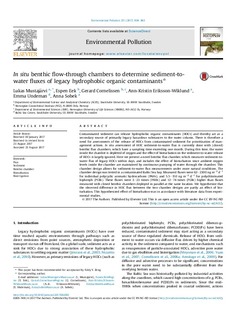In situ benthic flow-through chambers to determine sediment-to-water fluxes of legacy hydrophobic organic contaminants
Mustajärvi, Lukas; Eek, Espen; Cornelissen, Gerard; Eriksson-Wiklund, Ann-Kristin; Undeman, Emma; Sobek, Anna
Peer reviewed, Journal article
Published version
Permanent lenke
http://hdl.handle.net/11250/2463453Utgivelsesdato
2017Metadata
Vis full innførselSamlinger
- NGI articles [1037]
Sammendrag
Contaminated sediment can release hydrophobic organic contaminants (HOCs) and thereby act as a secondary source of primarily legacy hazardous substances to the water column. There is therefore a need for assessments of the release of HOCs from contaminated sediment for prioritization of management actions. In situ assessment of HOC sediment-to-water flux is currently done with (closed) benthic flux chambers, which have a sampling time exceeding one month. During this time, the water inside the chamber is depleted of oxygen and the effect of bioturbation on the sediment-to-water release of HOCs is largely ignored. Here we present a novel benthic flux chamber, which measures sediment-to-water flux of legacy HOCs within days, and includes the effect of bioturbation since ambient oxygen levels inside the chamber are maintained by continuous pumping of water through the chamber. This chamber design allows for sediment-to-water flux measurements under more natural conditions. The chamber design was tested in a contaminated Baltic Sea bay. Measured fluxes were 62-2300 ng m-2 d-1 for individual polycyclic aromatic hydrocarbons (PAHs), and 5.5-150 ng m-2 d-1 for polychlorinated biphenyls (PCBs). These fluxes were 3-23 times (PAHs) and 12-74 times (PCBs) higher than fluxes measured with closed benthic chambers deployed in parallel at the same location. We hypothesize that the observed difference in HOC flux between the two chamber designs are partly an effect of bioturbation. This hypothesized effect of bioturbation was in accordance with literature data from experimental studies.
